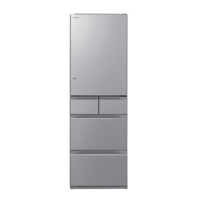64
TROUBLESHOOTING
If you experience any problems with the refrigerator, first check the table below and try the suggested solution.
Check SolutionProblem
Start of use
The refrigerator
is not very cold.
Have 24 hours passed since the refrigerator was installed?
Please wait. It might take 24 hours or more for the refrigerator to
become sufficiently cold. Leave spaces between items stored in the
refrigerator, and minimize how frequently you open and close the
refrigerator doors. Note that, in summer or if there are many items
in the refrigerator, it might take even longer than 24 hours for the
refrigerator to become sufficiently cold.
The ice maker is not
working.
Have 24 hours passed since the refrigerator was installed?
Please wait. It might take 24 hours or more for the refrigerator to
become cold enough to make ice. Leave spaces between items
stored in the refrigerator, and minimize how frequently you open
and close the refrigerator doors.
Frost or condensation
There is frost or
condensation inside
the refrigerator or
on the frames of
drawers.
There is
condensation on
the outer surface
of the refrigerator.
The refrigerator is too
cold, causing food to
freeze.
Ensure all containers are installed correctly.Are the containers in each compartment installed correctly?
Is there any food or packaging caught in the refrigerator door,
preventing the door from closing completely?
Ensure that nothing is caught in the door and that the door is
completely closed. In addition, pay attention to the heights of items
stored in each compartment or container.
Is the refrigerator overstuffed? Leave spaces between items stored in the refrigerator.
Is the refrigerator installed correctly and under the right conditions?
Depending on where and how the refrigerator is installed, various
factors might affect the refrigerator’ s cooling power. Ensure the
refrigerator is installed correctly.
Were any of the refrigerator compartment doors or drawers left
open?
When closing a door or drawer, ensure nothing (food or packaging) gets
caught and that the door or drawer closes all the way.
Were refrigerator doors left open for an extended period of time? Do
you open and close doors frequently?
When you open and close the refrigerator doors, moisture in the air
might condense or form ice crystals and stick to the walls of the
freezer compartment. Minimize how frequently you open and close
the refrigerator doors and how long doors remain open. Wipe away
the frost or condensation by using a dry dishcloth.
Is the space around the refrigerator humid?
When the humidity level is high (for example, on rainy days),
moisture in the air might condense onto the outer surface of the
refrigerator. Wipe away the condensation with a dry dishcloth.
Is the ambient temperature 5°C or lower?
When the ambient temperature is low, the refrigerator might
become too cold. Change the temperature setting to “■”.
Is the temperature setting set to “■■■”?
When the temperature setting is set to “■■■” , moisture in the
air might condense onto the outer surface of the refrigerator.
Change the temperature setting to “■■” . Wipe away the
condensation with a dry dishcloth.
Is the temperature setting set to “■■■”? Change the temperature setting to “■■”.
Were refrigerator doors left open for an extended period of time?
Do you open and close doors frequently?
While refrigerator doors are open, the temperature inside the
refrigerator gradually rises. Leaving doors open or opening doors
frequently can reduce the cooling power of the refrigerator.
Minimize how frequently you open and close the refrigerator doors
and how long doors remain open.
Was food placed in front of the cold air vent?
Do not place items directly in front of the cold air vent. Prevent food
from freezing by covering it with a lid or in plastic wrap.
Excessively cold
Is “Energy Saving” mode on? Turn “Energy Saving” mode off.
Does the control panel display keep changing?
If the control panel display keeps changing, this indicates that the
refrigerator is running in store-display mode. Turn store-display
mode off.
There is
condensation inside
the refrigerator
compartment.
Were refrigerator doors left open for an extended period of time?
Do you open and close doors frequently?
If the space around the refrigerator is humid or if you open and
close the refrigerator doors frequently,
moisture might condense on the interior
walls of the refrigerator compartment or
near the cold air vent. This does not
indicate any problem in the refrigerator’ s
functioning. Wipe away the condensation
with a dry dishcloth.
Condensation
Cooling power
The refrigerator
is not very cold.
Ice cream or
other frozen
foods are soft.
Is the temperature set to “ ■ ”?
Is the ambient temperature high (for example, if it is summer)?
Change the temperature setting for the applicable compartment to
“■■” or “■■■”.
There is condensation on
the back of the refrigerator
or on the wall.
Is the space around the refrigerator humid? Is there sufficient space
between the back of the refrigerator and the wall?
Ensure there is at least 2 cm of space between the back of the
refrigerator and the wall.
P.63
P.58
P.66
P.42
P.47,53
P.47,53
P.47,53
P.42

